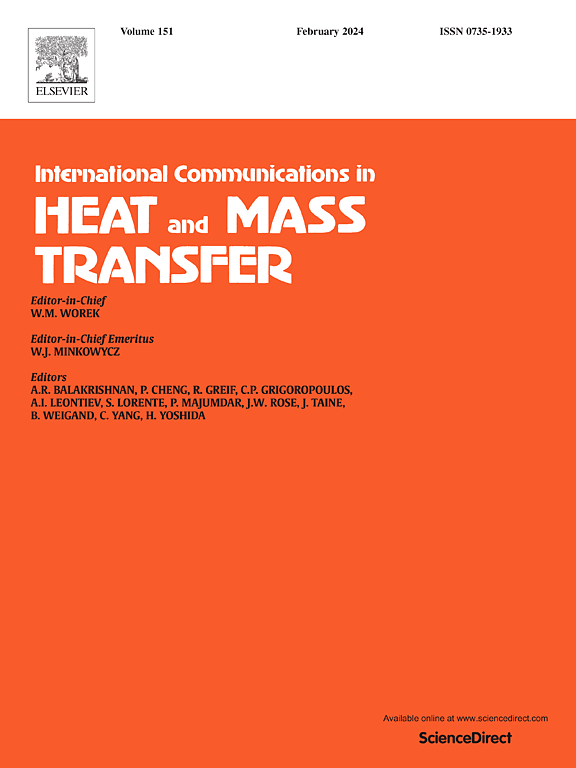蓄冷技术利用永磁体对空气进行自然对流
IF 6.4
2区 工程技术
Q1 MECHANICS
International Communications in Heat and Mass Transfer
Pub Date : 2025-05-29
DOI:10.1016/j.icheatmasstransfer.2025.109127
引用次数: 0
摘要
在一个由一对保持不同温度的垂直壁组成的立方容器中,用永磁体对含氧空气的自然对流施加磁场。对该结构进行了二维数值模拟,研究了棱柱形磁体的排列和形状对传热的影响。采用有限体积法对控制方程进行离散,并用SIMPLE算法求解。通过对一个磁四极问题的求解,验证了数值代码的准确性,结果与前人的研究结果吻合较好。无量纲参数设为普朗特数Pr=0.71,瑞利数Ra=10 5,磁数0≤Ma≤10。考虑的主要磁铁形状是方形横截面,占容器横截面面积的16%。磁体被移动,使其中心轴在0≤Xpm≤1.5或0≤Ypm≤1.5范围内变化。当磁体靠近容器顶部或右侧时,努塞尔数(Nu)显著降低,Ma=10时努塞尔数分别为3.38% ~ 22.3%和0.781 % ~ 37.4%。值得注意的是,Nu在磁体中轴线Ypm=0.84处达到最小值。本文章由计算机程序翻译,如有差异,请以英文原文为准。
Cool retention technology using permanent magnets on natural convection of air
A magnetic field was applied with permanent magnets to the natural convection of oxygen-containing air in a cubic container consisting of a pair of vertical walls maintained at different temperatures. Two-dimensional numerical simulations were performed on this configuration to investigate the change in heat transfer due to the arrangement and shape of the prismatic magnets. The governing equations were discretized using the finite volume method and solved with the SIMPLE algorithm. The accuracy of the numerical code was validated by solving a magnetic quadrupole problem, and the results showed good agreement with previous studies. The nondimensional parameters were set as Prandtl number , Rayleigh number , and magnetic number . The primary magnet shape considered was a square cross-section occupying 16 % of the container's cross-sectional area. The magnets were shifted so that their central axes varied within the ranges or . When the magnet was positioned near the top or right side of the container, the Nusselt number () significantly decreased, ranging from 3.38 % to 22.3 % and from 0.781 % to 37.4 % respectively for . Notably, reached its minimum when the central axis of the magnet was located at .
求助全文
通过发布文献求助,成功后即可免费获取论文全文。
去求助
来源期刊
CiteScore
11.00
自引率
10.00%
发文量
648
审稿时长
32 days
期刊介绍:
International Communications in Heat and Mass Transfer serves as a world forum for the rapid dissemination of new ideas, new measurement techniques, preliminary findings of ongoing investigations, discussions, and criticisms in the field of heat and mass transfer. Two types of manuscript will be considered for publication: communications (short reports of new work or discussions of work which has already been published) and summaries (abstracts of reports, theses or manuscripts which are too long for publication in full). Together with its companion publication, International Journal of Heat and Mass Transfer, with which it shares the same Board of Editors, this journal is read by research workers and engineers throughout the world.

 求助内容:
求助内容: 应助结果提醒方式:
应助结果提醒方式:


